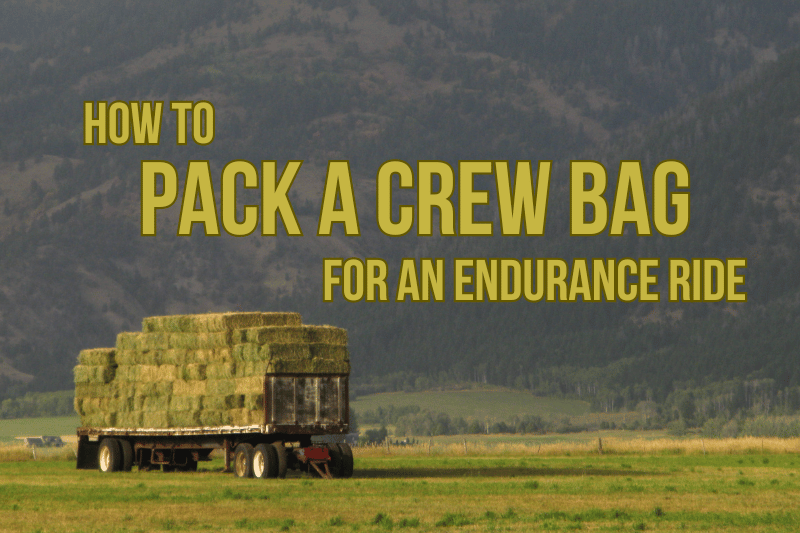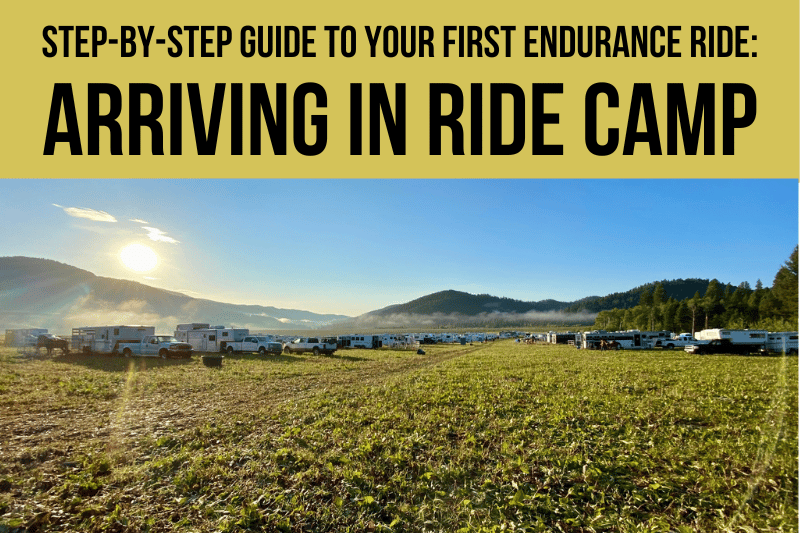Equestrian endurance riding involves many situations in which you need to care for your hardworking horse (not to mention yourself) without the luxury of a stable, or even your horse trailer.
A well-stocked crew bag makes this simple, even if you are riding without actual crew. This article covers where to get a crew bag and what to pack in it for your next endurance ride.
Why You Should Take a Crew Bag to Every Endurance Ride
I recommend taking a crew bag to every endurance ride, even if all holds are expected to be in camp. There are several reasons you might need it, including:
- If you ride with a buddy who isn’t parked nearby, you may need to spend the hold near her trailer so the horses will relax.
- If you end up camped far from the vetting area, you may not want to waste time walking back and forth.
- You may unexpectedly end up at a hold away from camp (commonly called an “out check”) due to last-minute trail changes.
Where to Buy a Crew Bag
You can buy very nice crew bags, such as this one from Distance Depot ($85) specifically for endurance riding.
My approach, however, is to visit the sporting goods and luggage sections of thrift stores. You can usually find large duffel bags for under ten bucks. They won’t come with the organizational features of a “real” crew bag, of course, so keep reading for easy solutions.
Whatever kind of bag you choose, expect it and its contents to get thrown, bounced, crushed, and soiled.
Add Some I.D.
At an out check, your crew bag may be part of a mountain of gear. Or, volunteers may have spread the bags out across a large area.
Either way, you’ll want your crew bag to be easy to identify from a distance. Pretend you’re checking it for an international flight and decorate it with colored ribbon or other distinctive markings.
Put your name and phone number on your bag, too, so it can find its way back to you if it gets lost. I loop a long piece of wide masking tape around the handle of my bag and write on it with Sharpie.
What to Pack in Your Crew Bag
When it comes to packing your crew bag, bear in mind that it may need to survive jostling, crushing, and hours of exposure to sun or rain. Here are some ideas for what to pack and how to organize it:
For the Horse
Hay – It’s often a good idea to have some alfalfa in addition to your usual hay, in case you need to tempt a picky eater. To keep the hay contained within a duffel-style crew bag, try putting it in this kind of hay bag.
Mash – Your beet pulp or other mash can soak while you ride. A plastic container with a screw-on lid works well. I use repurposed mixed nuts containers from Costco. Stomach soothers like aloe or hyaluronic acid gel can be added along with the water before you leave on your first loop.
Pellets or Grain — If you mix dry pellets or grain into your mash, it can be pre-measured and packed in a zip-top bag.
Feed Pan – You’ll need something to serve that mash in. I use a heavy rubber pan that’s just big enough to hold my mash container, pelleted feed, and a baggy of treats.
Treats – Carrots, apples, or Outlast treats can help get a reluctant horse to start eating (or simply encourage stretches).
Cooler – Regardless of the forecast, pack a blanket or cooler in case your horse gets chilled. To keep it clean, keep it zipped inside the plastic bag it came in when you bought it.
Electrolytes – Pack as much as you might need to administer at the hold, plus a refill for your saddle bags if you electrolyte on the trail.
Hoof Boots – Even if your horse is shod, you might need a spare tire. It’s a good idea to have boots in the right sizes for both front and rear hooves, just in case.
Need to buy something for your horse? You can support The Sweaty Equestrian blog (at no additional cost to you) by using my link to SmartPak. I appreciate it so very much!
For the Rider
Food – Keep this simple, since you’ll probably be holding your horse’s lead rope in one hand while you eat with the other. Unless you have an insulated lunchbox and ice pack, choose foods that won’t melt.
I like to pack a small, lidded plastic container with proteins (Epic bars), fats (nuts), and carbs (UCAN energy bars). Trail mix, granola bars, and Mama Chia, applesauce packets, and Uncrustables also work well.
Water – Even if management indicates that rider water will be provided, I always throw in a couple extra water bottles, just in case.
Thermos – For hot or cold weather, a thermos can keep a warming or refreshing beverage ready for hours. Pro top: On a hundred-miler, a thermos of iced coffee with cream really hits the spot in mid-afternoon!
Electrolytes – Most riders do best if they consume electrolytes before they feel deficient. I like to put a couple electrolyte capsules and a packet of LMNT in my lunch box so I remember to use them.
Jacket – Forecast notwithstanding, throw in a jacket in case conditions aren’t as expected.
Sunscreen – Remember to reapply, even if it’s cloudy.
Wet Wipes – These come in handy for all sorts of things, including if the porta-potty runs out of toilet paper.
Folding Stool – Some riders like to have a folding stool to sit on during the hold. Small tripod style stools are lightweight and convenient.
Late in a Very Long Ride, You Might Also Want:
- Change of clothes
- Headlamp
- Warm layers like gloves, hats, and jackets
- Ginger chews or Dramamine tablets to prevent nausea from riding in the dark
- Handwarmer packets
- Body Glide
- Stiff brush for your horse’s itchy coat
- Zinc-oxide cream for horse (scratches) and rider (heat rash)
You might also like
This post includes affiliate links, and I may earn a small commission (at no extra cost to you) when you purchase through these links. I only recommend products and services I think are helpful and useful. Thanks for helping me offset the cost of maintaining this blog as a free resource!






thank you for this list!
You’re very welcome! Thanks for reading!